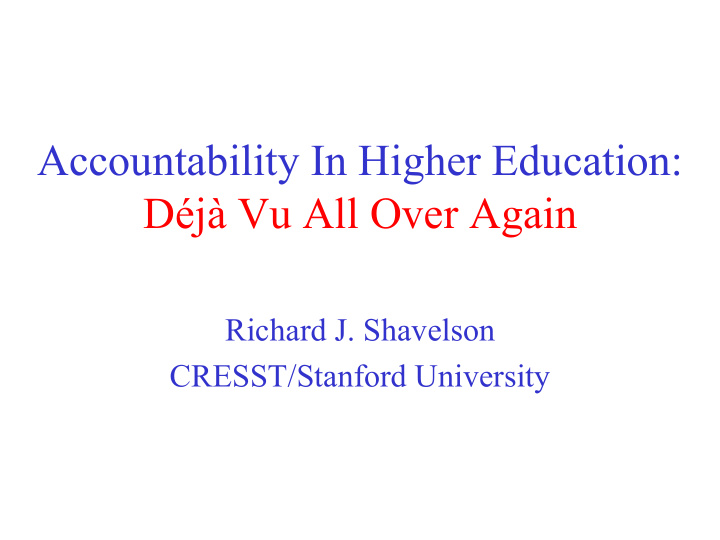



Accountability In Higher Education: Déjà Vu All Over Again Richard J. Shavelson CRESST/Stanford University
The Demand For Accountability • New York State Education Department plans to evaluate public and private colleges publishing a “report card” by 2001 • Virginia’s State Council of Higher Education announces its intention to put public colleges and universities on a performance budgeting and auditing system • New York and Virginia follow a trend in the United States (and other countries such as Britain and Australia) toward higher-education accountability. Better than half the states have policies designed both to ensure quality and to hold institutions accountable to a higher authority. 9/17/99 CRESST/Stanford University 2
Accountability Based On Faulty Logic • Accountability must be inferred from observing outcomes in any system where all actions cannot be observed directly. • To do this “inferencing,” the performance measure is an indicator of the desired behavior, not the behavior itself. – In business, there is a clear outcome measure (revenue or stock price) to guide business decisions and actions. You can’t manage a business if you can’t measure it’s outcome. – In education, outcomes are many and debated. The outcome indicator-- most often a multiple-choice achievement test, is but a proxy for the desired outcome. When this indicator becomes an end in itself, and it does in education, well-intentioned accountability may very well distort the system it was intended to improve. 9/17/99 CRESST/Stanford University 3
Alternative Models For Higher Education Accountability − Value-Added where a system’s performance is compared against its expected performance given the nature of its inputs. − Standards of Performance where the system’s performance is measured against some internal or external standard of minimally acceptable (or high level) of performance. − Time-Series that monitors system indicators (e.g., graduation rates, achievement scores) over time. − Internal Audit that links assessment of learning with the teaching and learning mission of the institution, with an externally verifiable internal quality-control mechanism. − External Audit that ties a system’s funding to indicators such as graduation rates, retention rates, and faculty teaching and research productivity. − Approximation that evaluates a system against predictors of student achievement over time such as active learning, student-faculty interaction, and student time on task. 9/17/99 CRESST/Stanford University 4
Déjà Vu All Over Again: K-12 Lessons Impact of proxies as if “real thing” for education outcomes: • Distorts curriculum--mile wide inch deep with facts • Teachers teach to test outside curriculum • Schools may cheat in various ways • Average test scores drift upward over time 9/17/99 CRESST/Stanford University 5
Some Possible Design Principles • Expand notion of “achievement” • Align formative and summative assessments • Account for and foster variability among institutions • Differentiate purposes of assessment and accountability – Public accountability – Teaching and learning improvement • Others 9/17/99 CRESST/Stanford University 6
Expand Notion Of Achievement Declarative Procedural Strategic Knowledge Knowledge Knowledge Characteristics That Vary According to Proficiency (Knowing the “ that ”) (Knowing the “ how ”) (Knowing the “ which ,” Level “ when ,” and “ why ”) Low High Extent ( How much? ) Domain-specific Production Problem schemata/ content: system-- Structure • facts strategies/ condition- ( How is it organized? ) • concepts action rules • principles operation systems Others (Precision? Efficiency? Automaticity?) Cognitive Cognitive Tools: Tools: Planning Planning Monitoring Monitoring 9/17/99 CRESST/Stanford University 7
The Mismatch Between Summative And Formative Evaluation • Summative Evaluation: Audience External to Educational Process – Externally mandated, high-stakes, cost and time economical accountability tests – Teacher assigned student grades • Formative Evaluation: Improvement of student learning (etc.) – Teacher classroom assessments – Student self-assessments 9/17/99 CRESST/Stanford University 8
Conceptual Framework For CLAS Aggregate Level of Performance A. Matrix Sample Benchmark: “Moderated” Score: Multiple-Choice & Individual, School Performance-Based & District Score Assessment Teacher Individual Level of Performance Moderation B. C. Sample from Class for Aggregation Portfolios Standardized Teacher Calibration & Curriculum-Embedded Professional Development Assessments 9/17/99 CRESST/Stanford University 9
Account For And Foster Variability • Student characteristics • Learning environments • Student outcomes – Achievement – Motivation – Civic responsibility 9/17/99 CRESST/Stanford University 10
Good And Bad News • Good News : Demand for accountability is warranted and if done well, could improve teaching and learning in higher education • Bad News : If current K-12 high-stakes accountability systems serve as models, the demand for accountability will harm not benefit higher education by significantly narrowing diversity of educational environments 9/17/99 CRESST/Stanford University 11
Recommend
More recommend